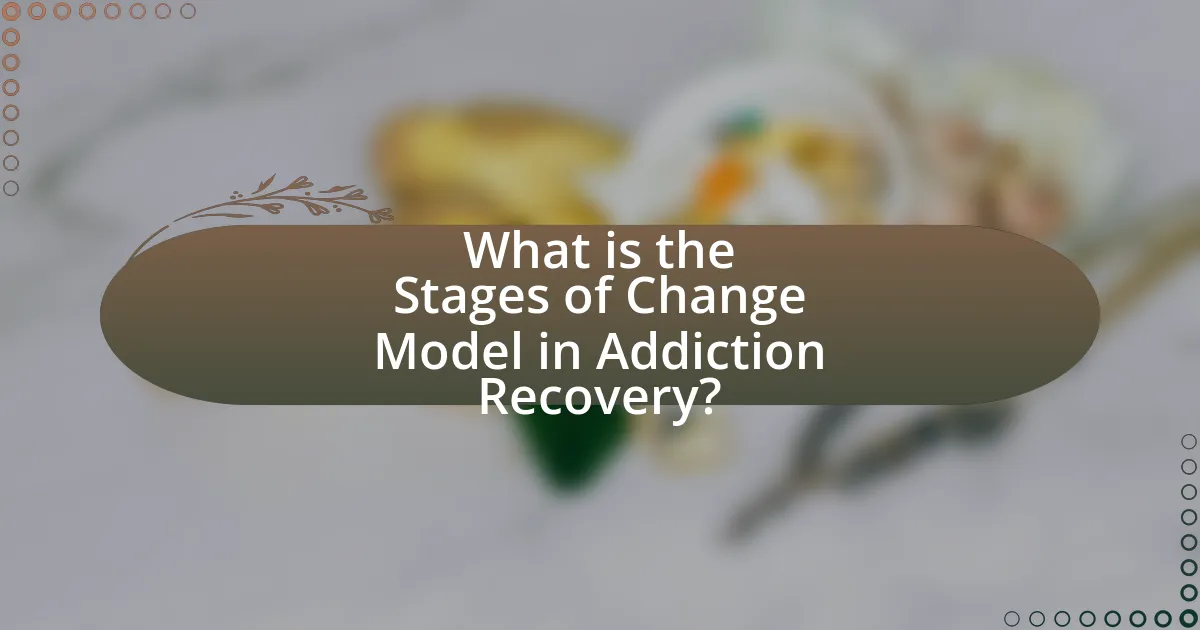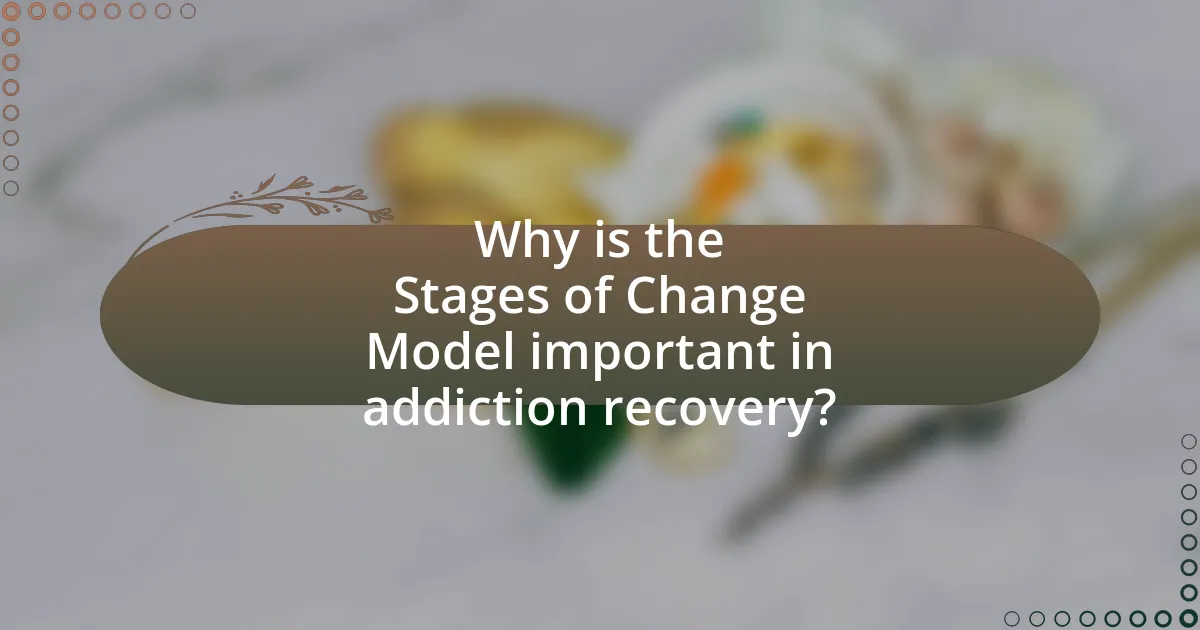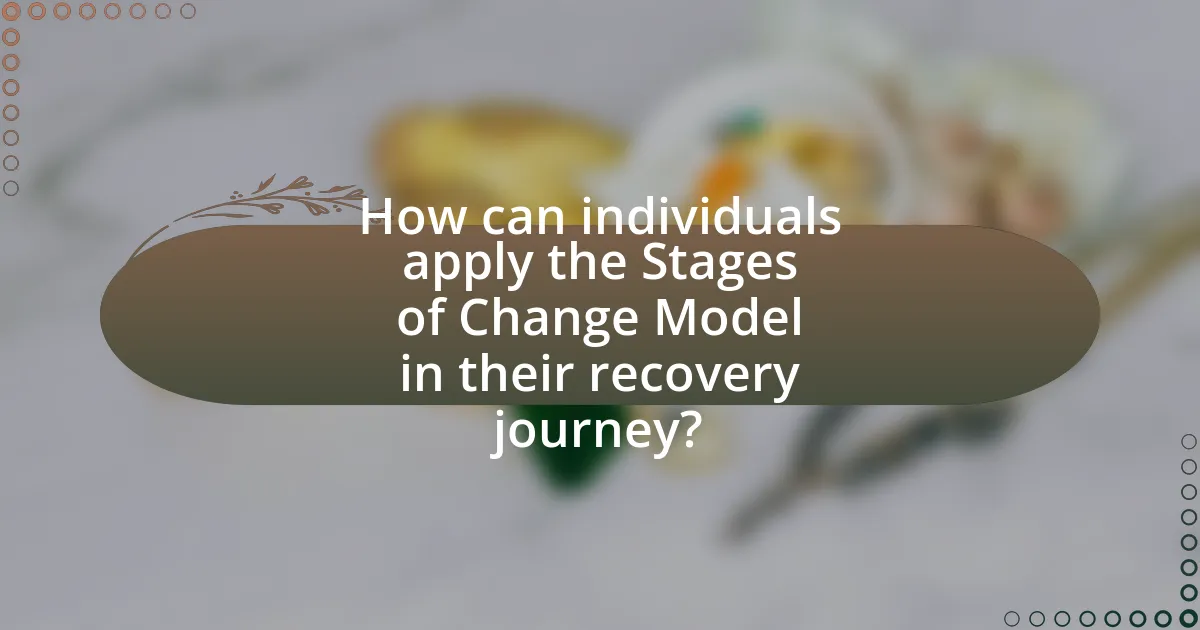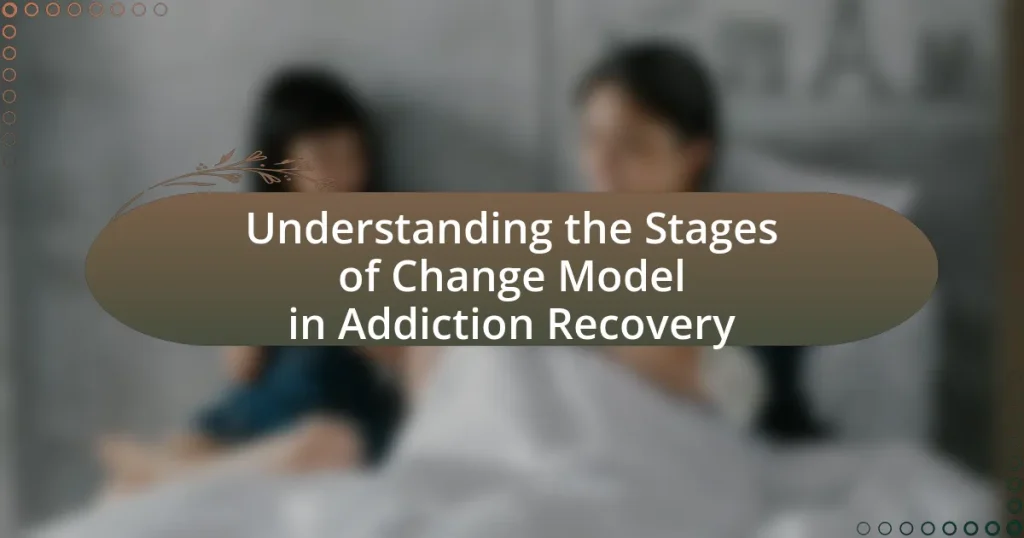The Stages of Change Model in Addiction Recovery is a psychological framework that outlines the five stages individuals experience when modifying addictive behaviors: Precontemplation, Contemplation, Preparation, Action, and Maintenance. Developed by James Prochaska and Carlo DiClemente in the late 1970s, this model emphasizes that behavior change is a non-linear process, allowing for relapse and re-engagement. The article explores the significance of each stage, the research supporting the model, and its application in tailoring interventions to enhance treatment outcomes in addiction recovery. Additionally, it discusses strategies for individuals to navigate their recovery journey effectively and the importance of personalized treatment plans.

What is the Stages of Change Model in Addiction Recovery?
The Stages of Change Model in Addiction Recovery is a psychological framework that outlines the process individuals go through when modifying behavior, particularly in overcoming addiction. This model consists of five stages: Precontemplation, Contemplation, Preparation, Action, and Maintenance. Each stage represents a different level of readiness to change, starting from not recognizing the need for change to actively maintaining new behaviors. Research by Prochaska and DiClemente in the late 1970s established this model, demonstrating that understanding these stages can enhance treatment effectiveness by tailoring interventions to an individual’s current stage of change.
How was the Stages of Change Model developed?
The Stages of Change Model was developed by James Prochaska and Carlo DiClemente in the late 1970s and early 1980s. This model emerged from their research on the processes of intentional change, particularly in the context of smoking cessation. Prochaska and DiClemente identified that individuals progress through a series of stages—precontemplation, contemplation, preparation, action, and maintenance—when modifying behavior. Their findings were based on a comprehensive review of various therapeutic approaches and the recognition that change is not linear but rather cyclical, allowing for relapse and re-engagement in the process. This model has since been widely applied in addiction recovery and other behavioral health interventions, demonstrating its effectiveness in understanding and facilitating behavior change.
Who were the key contributors to the development of this model?
The key contributors to the development of the Stages of Change Model in addiction recovery are James O. Prochaska and Carlo C. DiClemente. Prochaska and DiClemente introduced this model in their 1983 publication, “Stages of Change in the Modification of Problem Behaviors,” which outlined the process individuals undergo when changing behaviors, particularly in the context of addiction. Their research provided a framework that identifies five stages: precontemplation, contemplation, preparation, action, and maintenance, which has been widely adopted in various therapeutic settings.
What research supports the Stages of Change Model?
Research supporting the Stages of Change Model includes a variety of studies that validate its effectiveness in addiction recovery. One significant study is by Prochaska and DiClemente (1983), which introduced the model and demonstrated its applicability in smoking cessation programs, showing that individuals progress through distinct stages: precontemplation, contemplation, preparation, action, and maintenance. Further research, such as a meta-analysis by McMurray et al. (2015) published in the Journal of Substance Abuse Treatment, found that interventions based on the Stages of Change Model significantly improved treatment outcomes across various substance use disorders. Additionally, a study by Velicer et al. (1998) in the journal Health Psychology confirmed that tailoring interventions to an individual’s stage of change enhances engagement and success rates in behavioral modifications. These studies collectively provide robust evidence supporting the model’s utility in facilitating behavior change in addiction recovery contexts.
What are the main stages of the Stages of Change Model?
The main stages of the Stages of Change Model are Precontemplation, Contemplation, Preparation, Action, and Maintenance. This model, developed by Prochaska and DiClemente in the late 1970s, outlines the process individuals go through when changing behavior, particularly in the context of addiction recovery. Each stage represents a different level of readiness to change, with Precontemplation indicating a lack of awareness of the need for change, and Maintenance focusing on sustaining the change over time.
What characterizes the Precontemplation stage?
The Precontemplation stage is characterized by a lack of awareness or denial regarding the need for change in behavior. Individuals in this stage do not recognize their problematic behavior and are often resistant to acknowledging the consequences of their actions. Research indicates that people in the Precontemplation stage may feel demoralized or overwhelmed, leading them to avoid thinking about their issues. This stage is crucial in the Stages of Change Model, as it sets the foundation for future contemplation and potential action towards recovery.
How does the Contemplation stage differ from Precontemplation?
The Contemplation stage differs from Precontemplation in that individuals in Contemplation are aware of their problem and are considering making a change, while those in Precontemplation do not recognize the need for change. In the Contemplation stage, individuals actively think about the pros and cons of their behavior and may be ambivalent about taking action, indicating a readiness to explore options. Conversely, in Precontemplation, individuals are often unaware of the negative consequences of their behavior and may resist any discussion about change, reflecting a lack of insight into their situation. This distinction is crucial in the Stages of Change Model, as it informs the strategies needed to support individuals in their recovery journey.
What actions are taken during the Preparation stage?
During the Preparation stage of the Stages of Change Model in Addiction Recovery, individuals take specific actions to ready themselves for change. These actions include setting clear goals, developing a plan for achieving those goals, and gathering resources or support systems that will aid in the recovery process. Research indicates that individuals in this stage often begin to identify potential barriers to change and strategize ways to overcome them, which is crucial for successful transition into the Action stage.
What occurs in the Action stage of the model?
In the Action stage of the Stages of Change model, individuals actively implement strategies to modify their behavior and make significant changes in their lives. This stage involves taking concrete steps towards recovery, such as attending therapy sessions, participating in support groups, and adopting healthier habits. Research indicates that during this phase, individuals often experience increased motivation and commitment to their recovery goals, which can lead to improved outcomes in addiction treatment.
How is the Maintenance stage defined?
The Maintenance stage is defined as the phase in the Stages of Change Model where individuals work to sustain their recovery and prevent relapse after achieving initial behavior change. During this stage, individuals actively engage in strategies to maintain their new behaviors, such as ongoing support, coping mechanisms, and lifestyle adjustments. Research indicates that successful navigation of this stage can significantly reduce the likelihood of relapse, as evidenced by studies showing that individuals who remain in the Maintenance stage for extended periods demonstrate higher rates of sustained recovery (Prochaska & DiClemente, 1983).
What does Relapse mean in the context of this model?
Relapse in the context of the Stages of Change Model in addiction recovery refers to a return to substance use after a period of abstinence. This phenomenon is recognized as a common part of the recovery process, indicating that individuals may cycle through different stages, including precontemplation, contemplation, preparation, action, maintenance, and relapse. Research shows that approximately 40-60% of individuals in recovery experience relapse, highlighting its prevalence and the need for ongoing support and strategies to manage triggers and cravings effectively.

Why is the Stages of Change Model important in addiction recovery?
The Stages of Change Model is important in addiction recovery because it provides a structured framework for understanding the process individuals undergo when changing addictive behaviors. This model identifies five distinct stages: precontemplation, contemplation, preparation, action, and maintenance, allowing practitioners to tailor interventions based on an individual’s readiness to change. Research indicates that utilizing this model can enhance treatment outcomes by aligning therapeutic approaches with the specific stage of change a person is in, thereby increasing motivation and engagement in the recovery process. For instance, a study published in the Journal of Substance Abuse Treatment found that clients who received stage-matched interventions showed significantly higher rates of abstinence compared to those who did not.
How does this model facilitate understanding of addiction recovery?
The Stages of Change Model facilitates understanding of addiction recovery by providing a structured framework that outlines the process individuals undergo when changing addictive behaviors. This model identifies five distinct stages: precontemplation, contemplation, preparation, action, and maintenance, allowing both individuals and professionals to recognize where a person is in their recovery journey. Research indicates that understanding these stages can enhance motivation and tailor interventions effectively, as evidenced by a study published in the Journal of Substance Abuse Treatment, which found that individuals who were aware of their stage of change were more likely to engage in appropriate recovery strategies.
What insights does the model provide for individuals in recovery?
The Stages of Change Model provides individuals in recovery with a structured framework to understand their progress and readiness for change. This model outlines five stages: precontemplation, contemplation, preparation, action, and maintenance, allowing individuals to identify where they are in their recovery journey. Research indicates that recognizing one’s stage can enhance motivation and tailor interventions effectively, as individuals are more likely to engage in strategies that align with their current mindset and readiness to change. For instance, a study published in the Journal of Substance Abuse Treatment found that individuals who understood their stage of change reported higher levels of self-efficacy and commitment to recovery.
How can the model guide treatment professionals?
The Stages of Change Model can guide treatment professionals by providing a structured framework for understanding a client’s readiness to change their addictive behaviors. This model outlines five stages: precontemplation, contemplation, preparation, action, and maintenance, allowing professionals to tailor interventions based on the client’s current stage. For instance, in the precontemplation stage, a treatment professional might focus on raising awareness about the addiction, while in the action stage, they would emphasize developing coping strategies and support systems. Research by Prochaska and DiClemente, the creators of the model, demonstrates that aligning treatment strategies with a client’s stage of change significantly enhances engagement and outcomes in addiction recovery.
What are the benefits of using the Stages of Change Model?
The benefits of using the Stages of Change Model include its structured approach to understanding behavior change, which enhances motivation and facilitates tailored interventions. This model allows practitioners to identify an individual’s readiness to change, enabling them to provide appropriate support at each stage, from precontemplation to maintenance. Research indicates that interventions aligned with the individual’s stage of change lead to higher success rates in addiction recovery, as evidenced by a study published in the Journal of Substance Abuse Treatment, which found that stage-matched interventions significantly improved treatment outcomes.
How does the model promote self-efficacy in individuals?
The Stages of Change Model promotes self-efficacy in individuals by providing a structured framework that encourages personal agency and confidence in their ability to change behaviors. This model emphasizes the importance of recognizing one’s own progress through distinct stages—precontemplation, contemplation, preparation, action, and maintenance—allowing individuals to set achievable goals and celebrate small successes. Research indicates that individuals who perceive themselves as capable of making changes are more likely to engage in and sustain those changes, as evidenced by studies showing that self-efficacy is a significant predictor of successful outcomes in addiction recovery.
What role does the model play in personalized treatment plans?
The model plays a crucial role in personalized treatment plans by providing a structured framework that guides individuals through the stages of change in addiction recovery. This framework helps clinicians assess where a patient is in their recovery journey, allowing for tailored interventions that align with the individual’s readiness to change. Research indicates that utilizing the Stages of Change Model can enhance treatment outcomes by ensuring that strategies are appropriate for the patient’s current stage, whether it be precontemplation, contemplation, preparation, action, or maintenance. This targeted approach increases engagement and effectiveness, as evidenced by studies showing improved recovery rates when treatment aligns with the individual’s motivational state.

How can individuals apply the Stages of Change Model in their recovery journey?
Individuals can apply the Stages of Change Model in their recovery journey by identifying which stage they are currently in—precontemplation, contemplation, preparation, action, or maintenance—and tailoring their strategies accordingly. For instance, someone in the contemplation stage may benefit from education about the consequences of their addiction, while an individual in the action stage should focus on implementing specific recovery strategies, such as attending support groups or therapy sessions. Research indicates that understanding these stages can enhance motivation and facilitate progress, as individuals are more likely to engage in behaviors that align with their current readiness to change.
What strategies can individuals use to progress through the stages?
Individuals can progress through the stages of the Stages of Change Model in addiction recovery by employing specific strategies tailored to each stage. For instance, during the precontemplation stage, individuals can benefit from increasing awareness of their addiction through education and discussions with supportive peers or professionals. In the contemplation stage, individuals should weigh the pros and cons of change, which can be facilitated by journaling or engaging in motivational interviewing.
As individuals move into the preparation stage, creating a concrete action plan with achievable goals is crucial, often supported by counseling or support groups. In the action stage, individuals should actively implement their plans, utilizing coping strategies and seeking accountability from friends or support networks. Finally, in the maintenance stage, ongoing self-monitoring and participation in aftercare programs can help sustain recovery and prevent relapse.
Research indicates that these strategies align with the principles of the Stages of Change Model, which emphasizes the importance of tailored interventions at each stage to enhance motivation and commitment to change.
How can self-reflection aid in moving from Precontemplation to Contemplation?
Self-reflection aids in moving from Precontemplation to Contemplation by enabling individuals to recognize and evaluate their behaviors and the consequences of those behaviors. This process encourages awareness of the need for change, as individuals begin to question their current situation and consider the impact of their actions on their lives and relationships. Research indicates that self-reflection can lead to increased motivation for change, as individuals identify discrepancies between their current state and their desired state, fostering a desire to explore options for improvement.
What resources are available to support individuals in the Action stage?
Resources available to support individuals in the Action stage of the Stages of Change Model in Addiction Recovery include counseling services, support groups, and educational programs. Counseling services provide personalized guidance and strategies to help individuals implement changes in their behavior effectively. Support groups, such as Alcoholics Anonymous or Narcotics Anonymous, offer a community of peers who share similar experiences, fostering accountability and encouragement. Educational programs equip individuals with knowledge about addiction and coping mechanisms, enhancing their ability to maintain progress. These resources are essential for reinforcing commitment and facilitating sustained behavioral change during the Action stage.
What common challenges do individuals face when using the Stages of Change Model?
Individuals face several common challenges when using the Stages of Change Model, including difficulty in accurately identifying their current stage, resistance to change, and fluctuating motivation levels. Accurately identifying the current stage can be challenging because individuals may not fully recognize their behaviors or the need for change, leading to misalignment with the model. Resistance to change often arises from fear of the unknown or discomfort with the process, which can hinder progress. Additionally, motivation levels can fluctuate due to external factors such as stress or lack of support, making it difficult to maintain momentum through the stages. These challenges are supported by research indicating that individuals often struggle with self-awareness and motivation in behavior change contexts, as highlighted in studies on addiction recovery and behavior modification.
How can individuals overcome barriers in the Preparation stage?
Individuals can overcome barriers in the Preparation stage by setting specific, achievable goals and developing a structured action plan. This approach allows individuals to clarify their intentions and identify the necessary steps for change. Research indicates that goal-setting enhances motivation and commitment, which are crucial during this stage. For instance, a study published in the Journal of Consulting and Clinical Psychology found that individuals who set specific goals were more likely to succeed in behavior change compared to those who did not. By utilizing strategies such as seeking social support, utilizing resources, and addressing potential obstacles proactively, individuals can effectively navigate the challenges they face in the Preparation stage.
What strategies can help prevent relapse during the Maintenance stage?
To prevent relapse during the Maintenance stage of addiction recovery, individuals should implement strategies such as developing a strong support network, engaging in regular self-monitoring, and practicing coping skills. A strong support network, including friends, family, and support groups, provides emotional and practical assistance, which has been shown to reduce the likelihood of relapse. Regular self-monitoring helps individuals identify triggers and high-risk situations, allowing for proactive management of cravings. Additionally, practicing coping skills, such as stress management techniques and problem-solving strategies, equips individuals to handle challenges effectively, thereby decreasing the risk of returning to substance use. These strategies are supported by research indicating that social support and self-efficacy are critical factors in maintaining long-term recovery.
What practical tips can enhance the effectiveness of the Stages of Change Model?
To enhance the effectiveness of the Stages of Change Model in addiction recovery, individuals should set specific, measurable goals tailored to their current stage of change. This approach allows for clear benchmarks and progress tracking, which is crucial for motivation and accountability. Research indicates that goal-setting can significantly improve outcomes in behavioral change, as evidenced by a study published in the Journal of Consulting and Clinical Psychology, which found that participants who set specific goals were more likely to achieve desired changes compared to those who did not. Additionally, incorporating regular self-reflection and feedback mechanisms can help individuals assess their progress and adjust strategies as needed, further reinforcing commitment to change.
